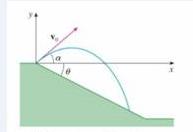
Concept explainers
(a) A projectile it fired from the origin down an inclined plain: that makes an angle θ with the horizontal. The angle of elevation of the gun and the initial speed of the projectile are α and rv. respectively. Find the position
(b) Show that the angle of elevation α that will maximize the downhill range it the angle halfway between the plane and the vertical.
(c) Suppose the projectile it fired up an inclined plane whose angle of inclination is θ Show that, in order to maximize the (uphill) range, the projectile should be fired in the direction halfway between the plane and the vertical.
(d) In a paper presented in 1686. Edmond Hailey summarized the laws of gravity and projectile motion and applied them to gunnery. One problem he posed involved firing a projectile to hit a target a distance 17 up an inclined plane. Show that the angle at which the projectile should be fired to hit the target but use the least amount of energy is the same as the angle in part (c). (Use the fact that the energy needed to fire the projectile is proportional to the square of the initial speed, so minimizing the energy is equivalent to minimizing the initial speed.)

FIGURE FOR PROBLEM 4
Want to see the full answer?
Check out a sample textbook solution
Chapter 13 Solutions
CALCULUS, EARLY TRANSITIONS (LL)
- Find the area of the shaded region. (a) 5- y 3 2- (1,4) (5,0) 1 3 4 5 6 (b) 3 y 2 Decide whether the problem can be solved using precalculus, or whether calculus is required. If the problem can be solved using precalculus, solve it. If the problem seems to require calculus, use a graphical or numerical approach to estimate the solution. STEP 1: Consider the figure in part (a). Since this region is simply a triangle, you may use precalculus methods to solve this part of the problem. First determine the height of the triangle and the length of the triangle's base. height 4 units units base 5 STEP 2: Compute the area of the triangle by employing a formula from precalculus, thus finding the area of the shaded region in part (a). 10 square units STEP 3: Consider the figure in part (b). Since this region is defined by a complicated curve, the problem seems to require calculus. Find an approximation of the shaded region by using a graphical approach. (Hint: Treat the shaded regi as…arrow_forwardSolve this differential equation: dy 0.05y(900 - y) dt y(0) = 2 y(t) =arrow_forwardSuppose that you are holding your toy submarine under the water. You release it and it begins to ascend. The graph models the depth of the submarine as a function of time. What is the domain and range of the function in the graph? 1- t (time) 1 2 4/5 6 7 8 -2 -3 456700 -4 -5 -6 -7 d (depth) -8 D: 00 t≤ R:arrow_forward0 5 -1 2 1 N = 1 to x = 3 Based on the graph above, estimate to one decimal place the average rate of change from x =arrow_forwardComplete the description of the piecewise function graphed below. Use interval notation to indicate the intervals. -7 -6 -5 -4 30 6 5 4 3 0 2 1 -1 5 6 + -2 -3 -5 456 -6 - { 1 if x Є f(x) = { 1 if x Є { 3 if x Єarrow_forwardComplete the description of the piecewise function graphed below. 6 5 -7-6-5-4-3-2-1 2 3 5 6 -1 -2 -3 -4 -5 { f(x) = { { -6 if -6x-2 if -2< x <1 if 1 < x <6arrow_forwardLet F = V where (x, y, z) x2 1 + sin² 2 +z2 and let A be the line integral of F along the curve x = tcost, y = t sint, z=t, starting on the plane z = 6.14 and ending on the plane z = 4.30. Then sin(3A) is -0.598 -0.649 0.767 0.278 0.502 0.010 -0.548 0.960arrow_forwardLet C be the intersection of the cylinder x² + y² = 2.95 with the plane z = 1.13x, with the clockwise orientation, as viewed from above. Then the value of cos (₤23 COS 2 y dx xdy+3 z dzis 3 z dz) is 0.131 -0.108 -0.891 -0.663 -0.428 0.561 -0.332 -0.387arrow_forward2 x² + 47 The partial fraction decomposition of f(x) g(x) can be written in the form of + x3 + 4x2 2 C I where f(x) = g(x) h(x) = h(x) + x +4arrow_forwardThe partial fraction decomposition of f(x) 4x 7 g(x) + where 3x4 f(x) = g(x) = - 52 –10 12x237x+28 can be written in the form ofarrow_forward1. Sketch the following piecewise function on the graph. (5 points) x<-1 3 x² -1≤ x ≤2 f(x) = = 1 ४ | N 2 x ≥ 2 -4- 3 2 -1- -4 -3 -2 -1 0 1 -1- --2- -3- -4- -N 2 3 4arrow_forward2. Let f(x) = 2x² + 6. Find and completely simplify the rate of change on the interval [3,3+h]. (5 points)arrow_forwardarrow_back_iosSEE MORE QUESTIONSarrow_forward_ios
 Algebra and Trigonometry (MindTap Course List)AlgebraISBN:9781305071742Author:James Stewart, Lothar Redlin, Saleem WatsonPublisher:Cengage LearningAlgebra & Trigonometry with Analytic GeometryAlgebraISBN:9781133382119Author:SwokowskiPublisher:Cengage
Algebra and Trigonometry (MindTap Course List)AlgebraISBN:9781305071742Author:James Stewart, Lothar Redlin, Saleem WatsonPublisher:Cengage LearningAlgebra & Trigonometry with Analytic GeometryAlgebraISBN:9781133382119Author:SwokowskiPublisher:Cengage Trigonometry (MindTap Course List)TrigonometryISBN:9781305652224Author:Charles P. McKeague, Mark D. TurnerPublisher:Cengage Learning
Trigonometry (MindTap Course List)TrigonometryISBN:9781305652224Author:Charles P. McKeague, Mark D. TurnerPublisher:Cengage Learning Trigonometry (MindTap Course List)TrigonometryISBN:9781337278461Author:Ron LarsonPublisher:Cengage Learning
Trigonometry (MindTap Course List)TrigonometryISBN:9781337278461Author:Ron LarsonPublisher:Cengage Learning Functions and Change: A Modeling Approach to Coll...AlgebraISBN:9781337111348Author:Bruce Crauder, Benny Evans, Alan NoellPublisher:Cengage Learning
Functions and Change: A Modeling Approach to Coll...AlgebraISBN:9781337111348Author:Bruce Crauder, Benny Evans, Alan NoellPublisher:Cengage Learning




